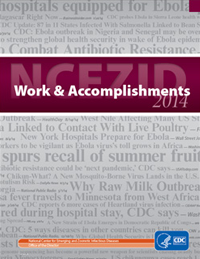NCEZID Work and Accomplishments 2014
Outbreaks:
- Multistate outbreak of Salmonella [page 2]
- Environmental mold infections in hospitals [page 2]
- Q fever at a dairy [page 2]
- Monkeypox investigation uses new technology [page 3]
- Contaminated equipment in hospitals [page 3]
- Investigating infections in a California NICU [page 3]
- Outbreak of botulism in Texas [page 3]
Food:
Bugs:
Ebola:
- NCEZID in action: Responding to Ebola [page 6]
- Mary Joung Won Choi: Building infection control in Guinea from the ground up [page 6]
- Abbigail Tumpey: Training our nation’s healthcare workers to fight Ebola [page 7]
- Tiffany Walker: Keeping heroes safe in Sierra Leone [page 7]
Healthcare:
- Tracking and improving antibiotic use [page 8]
- Targeting prevention to protect patients from healthcare-associated infections (HAIs) [page 8]
Border & Global Health:
Capacity & Innovation:
- Innovative sequencing quickly solves a Salmonella outbreak [page 10]
- Strengthening state and local capacity [page 10]
What’s Ahead in 2015:
